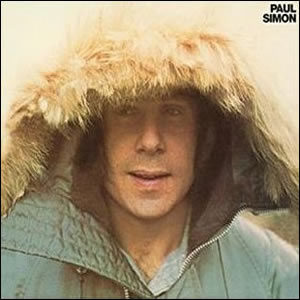Paul Simon
 Staking his own claim in the musical landscape, Paul Simon began exploring world influences with his 1972 eponymous album. It was his first post Simon and Garfunkel album, and let Simon subtly explorations musical genres from America and around the world. While there is much experimentation, most of the album;s songs have a stripped-down arrangement with a low-key feel, allowing Simon to shine brightly with his truly solo compositions. Paul Simon was actually the second solo album by this artist, as he had recorded and released an album in the U.K. in 1965, which remained unreleased in the U.S until 2005.
Staking his own claim in the musical landscape, Paul Simon began exploring world influences with his 1972 eponymous album. It was his first post Simon and Garfunkel album, and let Simon subtly explorations musical genres from America and around the world. While there is much experimentation, most of the album;s songs have a stripped-down arrangement with a low-key feel, allowing Simon to shine brightly with his truly solo compositions. Paul Simon was actually the second solo album by this artist, as he had recorded and released an album in the U.K. in 1965, which remained unreleased in the U.S until 2005.
Simon was actually teaching songwriting classes at New York University shortly after the split from Garfunkel in 1970. He then traveled to several locations to record demos and tracks for this album. Recordings took place in Kingston, Jamaica, Paris, and New York. Much of these recordings are individual performances with differing levels of production quality, but this serves to make the album all the more interesting. Since the album uses instrumentation so sparingly, the additional riffs and melodies make a greater impact during their short sequences.
The album contained many autobiographical elements lyrically, with several songs making explicit reference to Simon’s marriage to Peggy Harper, while others make more veiled references to Simon’s own adolescence, the place he grew up, and the challenges of the music industry.
 Paul Simon by Paul Simon |
|
|---|---|
| Released: January 14, 1972 (Columbia) Produced by: Roy Halee & Paul Simon Recorded: Various Locations, January-March 1971 |
|
| Side One | Side Two |
| Mother and Child Reunion Duncan Everything Put Together Falls Apart Run That Body Down Armistice Day |
Me and Julio Down By the School Yard Peace Like a River Papa Hobo Hobo’s Blues Paranoia Blues Congratulations |
| Primary Musicians | |
| Paul Simon – Lead Vocals, Guitars, Bass, Percussion Larry Knechtel – Piano, Organ Hal Blaine – Drums |
|
Recorded in Jamaica, “Mother and Child Reunion” may have been the very first mainstream use of reggae, something that would cascade in the years to follow. The song also includes a strong dose of Motown influence, making it a bit more unique that many of its pop successors. The song included a plethora of background musicians who would not appear anywhere else on the album. A sharp musical turn takes place with Celtic influenced folk song “Duncan”. The ringing guitars, banjo, dual flutes, and cheap and distant hi-hats accent this song of travel and discovery with a slightly Dylan-esque in lyrical approach (with flutes replacing harmonica).
“I was playing my guitar, lying underneath the stars, just thanking the Lord for my fingers…”
The remainder of side one explores some soft jazz compositions. “Everything Put Together Falls Apart” is the shortest and sparsest song, finger-picked acoustic nearly throughout with just a dash of bluesy piano. “Run That Body Down” is in the same basic genre, with a fuller musical arrangement using the whole spectrum of rock instruments and some surprise musical interludes, including an excellent guitar solo using heavy jazz wah-wah by Jerry Hahn. On “Armistice Day”, Simon really attacks the acoustic guitar with the most base type of musical discovery, almost violently, until the song evens out a bit with an electric guitar overlaid along with some topical horns.
The second side begins with the most popular song from this album, “Me and Julio Down by the Schoolyard”. Although upbeat and melodic, this song has some darker undertones about crime and drug use along with some cryptic lyrical puzzles. “Peace Like a River” is a kind of a bluesy folk song with some great arpeggio riffs throughout, and a very non-symmetrical arrangement. “Papa Hobo” is waltz-like with a bluesy acoustic and a distinct big bass harmonica by Charlie McCoy.
The hobo sequence continues with “Hobo’s Blues”, an upbeat, jazzy instrumental feature the violin of Stéphane Grappelli, who also co-wrote the song (the only one on the album not completely written by Simon). “Paranoia Blues” is straight-out acoustic blues with consistent kick-drum and hi-hat by Hal Blaine and lyrics that sum up as an anti-New York screed. The mellow ballad “Congratulations” completes the album with a softer, yet still bluesy acoustic and pleasant electric piano by Larry Knechtel who plays completely solo as the song and album ends.
The juxtaposition of simple, American genres along with some complex and original arrangements makes Paul Simon the first of several gems by this unique composer. You can say what you will about Simon, you can never call him unoriginal.
~
Part of Classic Rock Review’s celebration of 1972 albums.





Álbumes clásicos que cumplirán 50 años en 2022 - HISTORIA
October 20, 2023 @ 12:57 am
[…] and Julio Down by the Schoolyard», una alegre historia de crimen con infusión brasileña. eso Reseña de rock clásico Las afirmaciones abundan en «acertijos líricos crípticos». El resultado es un álbum ecléctico […]